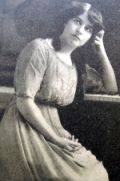The plot 'departs from the Arabian Nights tale as freely as the plots of most pantomimes do from their fairy book origins,' records the Argus, and deals instead
'with a voyage made by Sinbad to present a famous diamond to the Sultan of Serindip. A group of conspirators, including Steal, the arch villain and the inevitable Old Man of the Sea, seek to thwart him, and a storm is raised (providing the opportunity for a realistic stage setting), but after several vicissitudes, [Sinbad] triumphs over his foes, and wins the heart of the Sultan's daughter, the Princess Zoe' (23 December 1918, p.8).
Songs written for, or adapted into, the narrative included 'Cats on the Tiles', 'Nautical Captain Brown', 'The Ship of Love', 'Here Come the Anzacs', 'Flossie the Flapper', 'Dame of the Veils', 'Kiss Me', 'Knit, Knit', 'Dame of the Minchinbury', 'I'll Throw a Ring Around You', and two ballets: 'The Shell' and 'Butterfly'. The Argus reports that one un-named ballet, described as a 'Ju-jitsu dance with Apache elements', was 'a rather strained intrusion.' The critic went so far as to suggest that 'worked up, say, as an island dance scene [it] might possible be jammed in to advantage' (23 December 1918, p.8).


